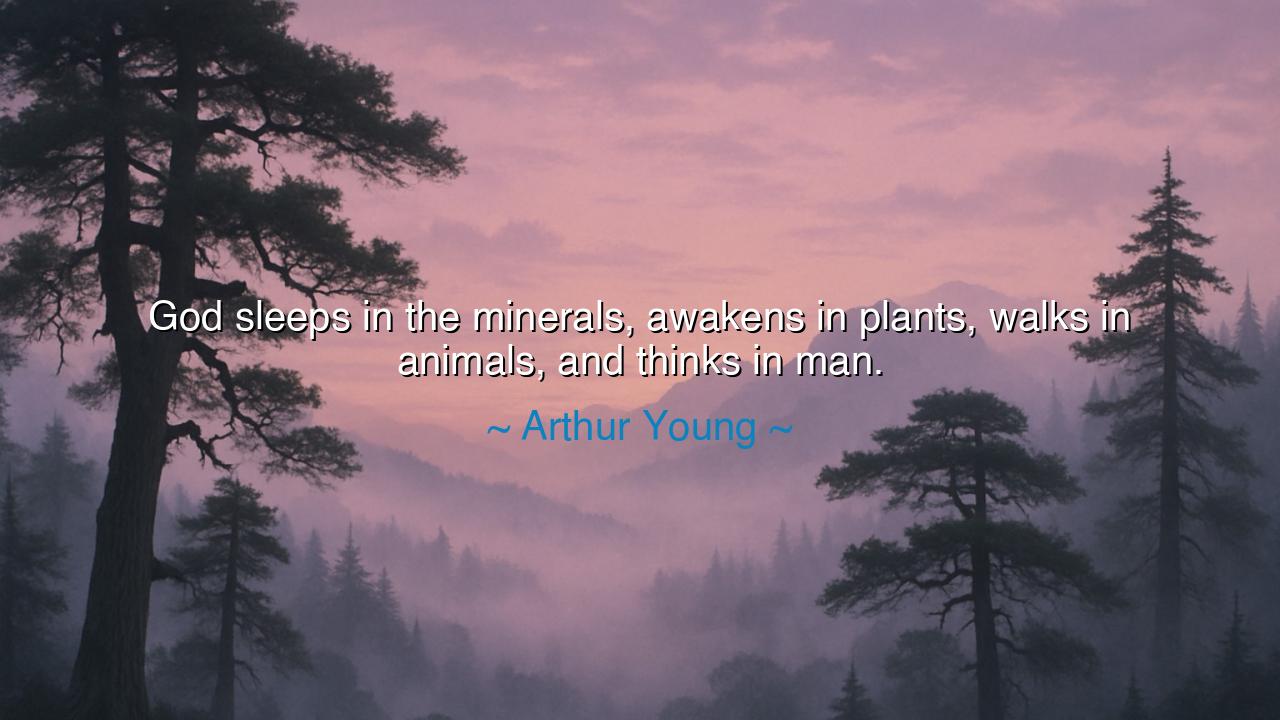
God sleeps in the minerals, awakens in plants, walks in animals






“God sleeps in the minerals, awakens in plants, walks in animals, and thinks in man.”
Thus spoke Arthur Young, the philosopher, scientist, and mystic, whose vision joined the language of creation with the song of evolution. In this profound declaration, he reveals the unfolding of divine consciousness through the hierarchy of life — from the stillness of stone to the awareness of humankind. His words do not speak of a distant deity, but of God as the living essence that animates all things. It is a vision at once mystical and scientific: that the universe itself is a grand awakening, a gradual rising of spirit from sleep to self-awareness, from silence to speech, from existence to enlightenment.
Arthur Young, who lived in the twentieth century, was no mere dreamer. He was the inventor of the Bell helicopter — a man of engineering and reason — yet his mind sought not only the mechanics of flight, but the metaphysics of being. In his later writings, particularly in The Reflexive Universe, he saw evolution not as a random chain of accidents, but as the awakening of consciousness itself. Matter, he believed, was the seed of spirit, and spirit, the destiny of matter. When he said that God “sleeps in the minerals,” he spoke of the divine essence lying dormant in the simplest forms of creation — the stones, the crystals, the elements — all of which carry, in their silence, the potential for life and awareness.
Then, in the plants, God “awakens.” The stillness of matter stirs with movement, with hunger for light. The seed breaks its shell and reaches upward — a gesture of longing, of life seeking the sun. Here, God begins to breathe. The plant has no eyes, no tongue, but it knows growth, it feels the rhythm of the seasons. In this awakening we glimpse the first stirring of divine will — the quiet assertion that being is not enough; life must reach. It is the same impulse that drives every soul toward light, every heart toward understanding. Even in the grass beneath our feet, there is the pulse of divinity learning to move.
Then God “walks in animals.” The divine energy, once bound in stone and rooted in soil, now takes motion and desire. The beasts of the earth carry instinct, emotion, and the first glimmers of personality. They hunt, love, protect, and fear. In their eyes we see reflection — a recognition, however faint, of the self and the other. Here, the divine walks upon the world, embodied in motion and experience. The creatures of the earth, the whales in the sea, the birds in the air — all are living prayers, expressions of that eternal force moving closer to awareness of itself. In them, life no longer merely exists; it begins to feel.
Finally, in man, God thinks. The divine has reached the summit of its own creation — no longer asleep, no longer only moving or feeling, but now conscious of itself. Man is not merely part of the world; he knows that he is. Through him, the universe becomes aware of its own being. This is the mystery of spirit made flesh — that the same essence that sleeps in the rock and grows in the tree now speaks, dreams, and questions the heavens. Yet this thinking is not the end, but another threshold. For in man’s thought lies the possibility of return — to look inward and remember that the source of his intellect, his wonder, and his love is divine.
History gives us glimpses of those who embodied this truth — souls in whom thought became illumination. Leonardo da Vinci, who saw no division between art, science, and spirit, perceived this divine unity in all things: the flight of birds, the curves of rivers, the anatomy of man. Albert Einstein, too, spoke of the “cosmic religious feeling” that arises when one perceives the order and beauty of the universe. In each of these seekers, God was not a distant ruler but a living presence within the mind itself — thinking, discovering, awakening further through the human vessel. They remind us that the purpose of knowledge is not dominion, but reverence — the realization that to think is to partake in the very act of creation.
The lesson, then, is one of both humility and glory. We are not separate from creation’s chain; we are its continuation, its flowering. Within us, the mineral, the plant, and the animal all live — the solidity of earth, the yearning of growth, the passion of life. But above these, we carry the spark of divine awareness, the ability to reflect upon being itself. Therefore, we must honor all forms of life as sacred, for each is a stage of God’s awakening. The stone is not dead; it is sleeping. The flower is not simple; it is dreaming. The animal is not lesser; it is feeling. And man is not master, but mind of the whole.
So, my child of stardust and breath, remember this truth of Arthur Young: the divine sleeps, awakens, walks, and thinks through all things. To live wisely is to awaken further — to move from mere thought toward understanding, from understanding toward love, and from love toward unity. Seek not only to think as man, but to feel as the living world, to awaken as the plant, and to rest as the stone — for in doing so, you will remember what all creation proclaims: that the universe is not a machine, but a dream of God, ever awakening to its own light.






AAdministratorAdministrator
Welcome, honored guests. Please leave a comment, we will respond soon